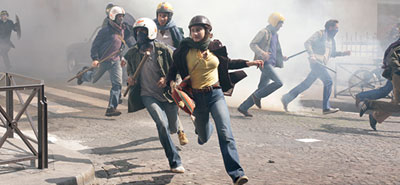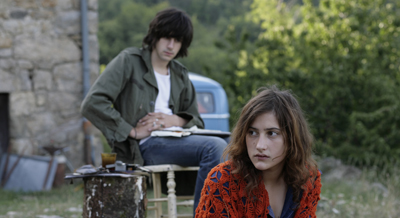 Gilles, Christine, and Alain are pretty much like your normal American teenagers. They stay out late, drink and smoke, sneak into movies, have furtive sex. Then, ten minutes into Something in the Air they're being brutally beaten and tear-gassed by French police for protesting in the streets. We're definitely not in John Hughes territory: this is suburban Paris in 1971 and the winds are blowing change. It's the height of the student protests following the May 1968 general strike. There's only a little context given in the film to these historical events: despite being a major motivation for the characters, writer/director Olivier Assayas plays the social aspect economically, spurring Gilles & Co. into action, but for the sake of the film's forward motion they could just as well be marching in the streets for civil rights, against the Vietnam War, or for that matter, to stop the wicked machinations of Voldemort. That they believe in their cause is a background; that they believe in it so utterly passionately is. You could do your homework and spend a few hours on Wikipedia getting yourself edumacated on the subject, but it really doesn't matter—not any more than it would take being Shelby Foote to appreciate Gone with the Wind.
Gilles, Christine, and Alain are pretty much like your normal American teenagers. They stay out late, drink and smoke, sneak into movies, have furtive sex. Then, ten minutes into Something in the Air they're being brutally beaten and tear-gassed by French police for protesting in the streets. We're definitely not in John Hughes territory: this is suburban Paris in 1971 and the winds are blowing change. It's the height of the student protests following the May 1968 general strike. There's only a little context given in the film to these historical events: despite being a major motivation for the characters, writer/director Olivier Assayas plays the social aspect economically, spurring Gilles & Co. into action, but for the sake of the film's forward motion they could just as well be marching in the streets for civil rights, against the Vietnam War, or for that matter, to stop the wicked machinations of Voldemort. That they believe in their cause is a background; that they believe in it so utterly passionately is. You could do your homework and spend a few hours on Wikipedia getting yourself edumacated on the subject, but it really doesn't matter—not any more than it would take being Shelby Foote to appreciate Gone with the Wind.

Turns out this semi-autobiographical film by Assayas (director of one of my favorite contemporary French films, Irma Vep) really isn't that different than Harry Potter: the kids are both exceptional and purposeful (extraordinarily so) about their beliefs, suspicious of grown-ups (when they appear in the film), and drawn deeper and more seriously into the activism throughout the movie's first half. Gilles pretty much has it all: he's a gorgeously shaggy-maned, dewy-eyed student, an artist and activist with a beautiful girl friend. He's an intelligent and voracious reader, a junior fatalist with apparently no parents (indeed, few adult authority figures appear until much later in the movie). The conversations of Gilles and his friends are all political, and their after-hours civil disobedience escalates from graffiti on their school building to firebombing, an attack which inadvertently results in the brain damage of one of the guards trying to catch them.
That's only the first act. An entire film about these cigarette-smoking passionately argumentative youths might have been dreary. Their conversations are all political and they go through life with hardly a happy look...smiles are reserved for their "we're happy we'll be having sex and/or acid soon" moments. Gilles is a poster child for the adjectives earnest and intense. After showing his girlfriend one of his paintings, he immediately burns it. "This was for you. You saw it—no one else must." You just want them to go ride g-karts or play pinball for a while. You damn kids get off my lawn!
It's in the film's middle section that the poignant and powerful heart of Something in the Air is revealed. Gilles, Christine and Alain flee to Italy for the summer to avoid being arrested. Their political trip gradually becomes more aimless both in locale and ideology, a physical and mental wandering despite their resolute intentions to join up the Italian left. Assayas hits these story beats with well-timed energy and without preaching—Christine and Alain follow new lovers and Gilles meanders. Desperately trying to find meaning in their lives and the world, they wind up ultimately doing silly hippie things. Assayas not only perfectly captures that pretentious idealism we all have when we're young but the times when the scales fall off our eyes. It's one of the more subtle coming-of-age films I've seen: Assayas convincingly, touchingly reverses the usual path of growing maturity: sexual, social, and political awareness, their entire lives at the beginning of the film, gradually give way to creativity and self-interest, and their activist lives sputter as they move into mundane but happier worlds.

By the end of the film Gilles is still arguing with his father, but now it's about the portrayal of Georges Simenon's detective Maigret in his film adaptations. He leaves France again, but now to go to London to work as a gofer at Pinewood Studios on a science fiction film. Assayas risks breaking a cardinal film rule by inserting this admittedly more visually compelling film inside his own: Nazi! Dinosaurs! And a bikini babe! It looks like the best film ever, but Assayas has us right where he wants us: we're more interested to follow Gilles through his Very Important Year of 1971. He probably grew up and became a filmmaker and made a movie just like Something in the Air.
This is a dense film but a captivating one: the young leads are very impressive and despite the usual few historical anachronisms (music from a 1972 Robin Williamson album appears in the soundtrack; London Underground "Way Out" signs are entirely modern), Assayas has built and captured the authentic looks, sounds, and feel of an uncertain age that wanders between hard military violence and languorous stoned bliss. The hefty dose of politics is never beside the point, but it's never a political film. It's a film of youth and love and realization and discontent and disillusionment, echoes of life played out on the backdrop of history but ultimately upstaging its grimmer reality. The kids' intensity and energy, both social and romantic, are utterly infectious and I cared for them very deeply. This is the movie from the New York Film Festival, more so than the others (including the I-loved-it Life of Pi), that I've thought about the most, and become more appreciative of on each contemplation. Something in the Air doesn't have the splash of commercial accessibility of Life of Pi or Lincoln, but it's one of the most important films of the festival. Maybe the most important.
Something in the Air premiered at the 50th New York Film Festival on Friday, October 5; subsequent showtime on October 12.
No comments:
Post a Comment